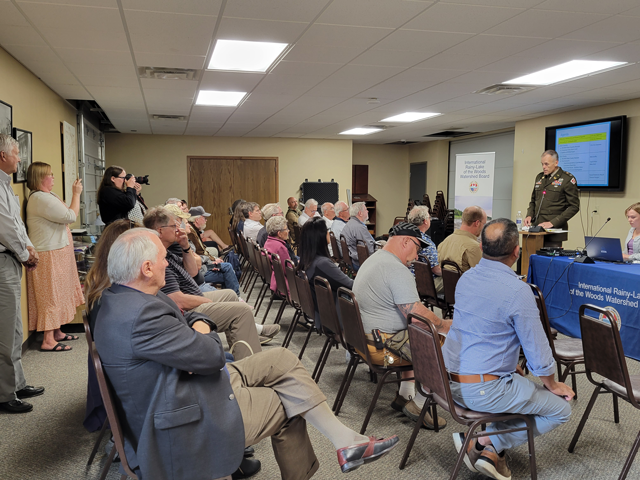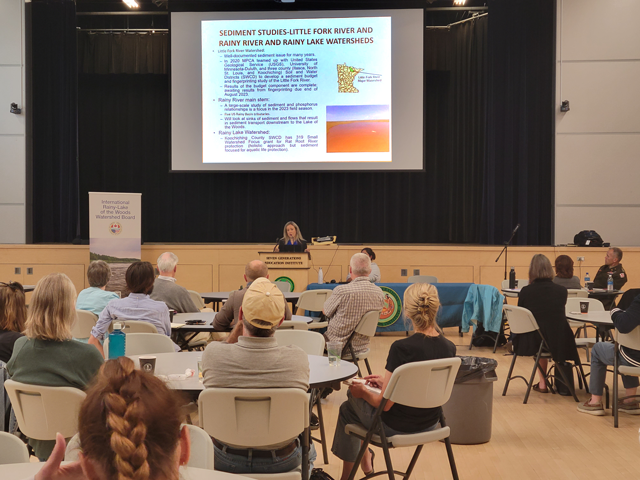 Crowd at public meeting of watershed board in Baudette, MN. Col. Eric Swenson, US Co-chair of IJC watershed board presenting. Photo; Alexandria Farrell, IJCThe IJC’s International Rainy-Lake of the Woods Watershed Board held its annual meetings with the public in Baudette, Minnesota on August 16 and Kenora, Ontario on August 17.
Crowd at public meeting of watershed board in Baudette, MN. Col. Eric Swenson, US Co-chair of IJC watershed board presenting. Photo; Alexandria Farrell, IJCThe IJC’s International Rainy-Lake of the Woods Watershed Board held its annual meetings with the public in Baudette, Minnesota on August 16 and Kenora, Ontario on August 17.
The IJC watershed board presented an update on its activities during the past year and key priorities for the coming year. The Aquatic Ecosystem Health Committee of the IJC watershed board is leading several projects this year, including:
- A project to develop a) international water quality objectives for phosphorus for Lake of the Woods and the Rainy River; b) advisory Alert Level triggers for other substances; and c) technical design requirements for an international long term monitoring program to support the objectives and alerts system.
- Development of an Exceedance Report focused on phosphorus and algal indicator conditions on Lake of the Woods and Rainy River, along with reporting of exceedances or spills (if any) from permitted wastewater dischargers.
- Investigation of erosion patterns of the South Shore barrier islands in Lake of the Woods out from the mouth of the Rainy River.
- A preliminary inventory of mining information in the watershed to support future assessment of risks from mining in the watershed.
The Water Levels Committee (WLC) of the IJC watershed board has responsibilities for water levels on Rainy and Namakan Lakes. The WLC has prepared a “Rainy-Namakan post-flood report” on the historic flooding last year in these two lakes. Water levels on Lake of the Woods are managed by the Canadian Lake of the Woods Control Board and it has also released a post-flood report for last year’s flood on Lake of the Woods. Canadian Lake of the Wood Control Board engineer Megan Garner explained that there is strong integration and cross-pollination among the boards to manage our waters as a system, sharing the same engineering support, even though there are separate boards with responsibility for Rainy-Namakan and for Lake of the Woods.
Key issues raised by the public included expansion of tile drainage in the Canadian side of the Rainy River, with concerns about potential for increased nutrient loading, invasive flowering rush becoming established at the north end of Lake of the Woods and Clearwater Bay, and concerns about the proposal from the Nuclear Waste Management Organization (NWMO) for potential deep-geologic storage of nuclear waste near Ignace, Ontario. Although the proposed site is outside of surface drainage of the Rainy-Lake of the Watershed, the IJC watershed board has this issue on a watching brief as there is still uncertainty about whether there is potential for ground water interchange into the Rainy-Lake of the Woods basin.
 MPCA's Theresa Haugen, presents update to public in Kenora, on sediment fingerprinting studies - part of Minnesota's work to cut phosphorus loads to the Rainy River and Lake of the Woods. Photo: Alexandra Farrell, IJCThe IJC watershed board also hosted guest presentations by the Minnesota Pollution Control Agency (MPCA) and Environment and Climate Change Canada (ECCC) on these agencies’ work to address the phosphorus loading that feeds the excessive algae blooms on Lake of the Woods.
MPCA's Theresa Haugen, presents update to public in Kenora, on sediment fingerprinting studies - part of Minnesota's work to cut phosphorus loads to the Rainy River and Lake of the Woods. Photo: Alexandra Farrell, IJCThe IJC watershed board also hosted guest presentations by the Minnesota Pollution Control Agency (MPCA) and Environment and Climate Change Canada (ECCC) on these agencies’ work to address the phosphorus loading that feeds the excessive algae blooms on Lake of the Woods.
The MPCA’s Theresa Haugen, presented an update on work in Minnesota to cut phosphorus entering the Rainy River and Lake of the Woods, noting that there has been substantial progress in reducing phosphorus from industrial and municipal wastewater. Re-permitting of most point sources has been completed and a number of watershed restoration plans (WRAPS) have been developed to address more diffuse landscape sources of phosphorus, to align with phosphorus targets set in Minnesota’s Lake of the Woods Total Maximum Daily Load study. Currently underway is re-permitting of the paper mill in International Falls, to set a new phosphorus limit.
Daniel Rokitnicki from Environment and Climate Change Canada presented an update on Canada’s Lake of the Woods science program and the announcement in Canada’s federal budget of the establishment of a new Canada Water Agency, that will have responsibility and budgets for 8 significant water bodies, specifically including Lake of the Woods. ECCC’s key priorities for Lake of the Woods include: a) establishing Canadian domestic phosphorus load reduction targets and then binational targets with the US; b) continuing to engage with Indigenous partners in Treaty #3 territory; and c) continuing core monitoring and research. Currently, the Canada Water Agency is being operated as a branch within ECCC, but in 2024 will migrate to a stand-alone agency headquartered in Winnipeg, MB.
